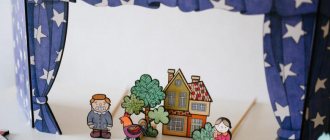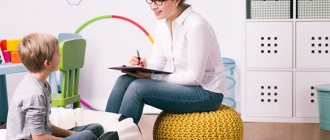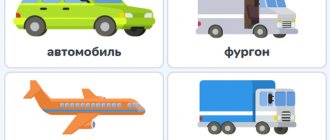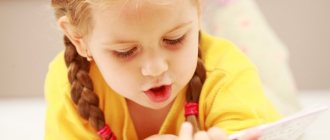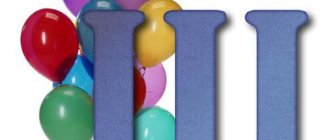Speech therapy classes
— a section with notes on group, frontal, individual speech therapy and logorhythmic classes, as well as integrated classes, master classes on non-traditional teaching methods. We are confident that the materials posted here will be interesting and informative not only for specialists in children's educational institutions, but also for parents who show a sincere interest in the development of their child.
Experienced specialists share their knowledge here, and for beginning speech therapists, the presented notes will help them plan their classes correctly and in a fun way.
Typical speech disorders in children 5-6 years old
Most older preschoolers have difficulties with:
- mastering sonorous and hissing sounds;
- sound analysis of words;
- development of narrative speech;
- writing a story and descriptions.
Of course, such problems can be minor, only slightly different from the age norm, or serious, up to and including general speech underdevelopment (GSD). It is necessary to contact a speech therapist in any case, but the supportive work of parents at home is also very important.
It is worth noting that regular speech therapy exercises and classes for children 5-6 years old are useful for every child at home, because they help to master literacy faster.
Types of defects
I propose to begin by considering the types of speech disorders. There are many of them, but each child has his own.
- Stuttering. This is a fairly common phenomenon. You can notice it around the age of 3, at which time the first sentences begin to form. It is important to immediately contact a good speech therapist. After all, no specialist can guarantee that in a couple of years the problem will not return again...
- Dislalia. The word is very clever! But behind this lies another common problem for preschool children - incorrect pronunciation of consonant sounds. This is especially true for “R”, “L” and “W”.
- Nasality. Here, of course, the main role is played by the natural factor - the incorrect structure of the speech apparatus. And it would be very good to visit an otolaryngologist to solve this problem.
- General speech underdevelopment (GSD). Here, dear readers, close relatives of the baby are often the culprits. Various kinds of baby talk and insufficient communication lead to the child constantly confusing everything. I'm talking about endings in words, confusing prepositions, etc. This can have a bad effect later. After all, school is coming soon!
- Congenital pathologies of a neurological nature. Complex treatment from a neurologist is already required.
- With delayed speech development (SDD). This usually manifests itself around the age of 3. After all, at this time children babble non-stop! Therefore, if you have a short vocabulary, contact a specialist without delay!
Pay proper attention to your little one. Monitor your child's speech. And in case of gaps, seek help from a doctor!
Rules for speech therapy classes at home
The success of home lessons depends not only on the availability of the necessary aids and a work plan agreed upon with the speech therapist. The organization of classes itself is very important. Here are a few simple rules that will help you achieve excellent results:
- All speech therapy exercises for children should be carried out regularly, but a little at a time. You shouldn’t try to do articulation gymnastics, play speech games, or fill out a workbook right away. It is better to devote a few minutes to each type of exercise, rather than having a whole “speech therapy day.”
- Do not force them to complete tasks under pressure; educational activities for children should resemble a game. Come up with a simple plot (for example, a journey into the universe of sounds), prepare small prizes (stickers, paper stars), and arrange physical exercises.
- Praise and support the little student if he makes even the slightest progress. Focus on achievements, even small ones, gradually progress will become more and more obvious.
- Find good workbooks for home practice. They should not only be professional in content, but also bright, colorful, and exciting. It is ideal if the tasks have interactive elements (the opportunity to add something, draw something). Such material makes it possible to interest a preschooler and clearly shows him the “path traveled” and success.
- Don't expect instant results, be patient and gentle perseverance. The process of setting, consolidating, and differentiating sounds is complex; it takes months even for experienced speech therapists. Follow the plan and the results will gradually appear.
A diagnosis of mental retardation is not a death sentence
There are parents who imagine and invent defects for their child. It’s not for nothing that people say: “It’s better to be safe than sorry.” But there are those who point blank see nothing wrong. But by the age of 5, a child should already be able to express his thoughts in understandable phrases. Do not confuse syllables in words.
There are several diagnoses that baffle parents.
- ZRR. When only the word pronunciation is underdeveloped, but mentally the child is fine. It’s good if it is detected before 4–5 years of age, since then another stage begins: zprr.
- ZPRR delayed psycho-speech development. When the child’s psyche and mental abilities are also involved in the process.
- ZPR is just mental development. The speech apparatus also suffers, but the basis here is the baby’s psyche.
I will not talk about the reasons that prompt such states. But, if this happened, then the rule of speech therapists (and all other doctors!) is observed here. And it says: “The sooner the better.” I hope you understand that, as with any disease, there are more complex forms.
Be sure to find a good specialist who will find a common language with the baby. Most likely, a neurologist should also be involved here. But first of all, maintain a good emotional background at home. Believe me, a lot depends on this. Well, now I’ll write recommendations for exercises with mental retardation.
Speech therapy exercises for practicing at home
All speech therapy exercises can be divided into three large blocks, each of which needs to be given attention and carried out regularly:
Development of phonemic hearing
The ability to distinguish sounds by ear seems natural, but if you ask your preschooler to spell a word, you will see gaps.
For children 5-6 years old, there are a large number of special games and exercises that help develop phonemic hearing. These include:
- selection of words starting or ending with a given sound;
- counting sounds in a word, determining the syllable structure;
- drawing up a sound diagram of a word;
- inventing rhymes and short poems;
- pronouncing speeches and tongue twisters.
Thoughtful speech therapy classes for children 5-6 years old make it possible to make all the sounds of their native language obedient and easy.
Finger gymnastics
Fine motor skills of the hands help speech activity, so older preschoolers must do it without fail.
Of course, for children 5-6 years old, the exercises should be complex, with a script, in verse. It is useful to select sets of exercises for both hands at the same time, synchronous. Don't forget to use "helpers":
- small massagers (rubber balls, rollers, cones);
- scissors for cutting;
- plasticine;
- origami paper.
Also remember that all types of needlework, construction, and any creativity are great ways to improve fine motor skills outside of individual lessons.
Articulation gymnastics
Special language exercises must be performed every day if there are any problems with pronunciation. For home exercises, it is best to choose a set of exercises with a poetic description and pictures.
Do a tongue warm-up every day, always in front of a mirror (this allows the baby to observe the process himself, assessing its success). If you have problems with one or two sounds, then articulatory gymnastics should be selected for them. These can be found in thematic workbooks on speech therapy.
Final chords
We learn to speak clearly, competently and beautifully, first of all, for ourselves. The desire not to stand still, to develop, to set goals, to go towards them - all this gives us energy and makes us strong. And if we try to make our thoughts and feelings beautiful, then we will succeed. After all, thoughts are born from feelings, thoughts are clothed in words, and words are the components of our speech.
We will share our creative energy with children to help them overcome the problems that arise. How else?
Speech therapy tasks
Starting with the letter R
One of the most difficult sounds to master is R. Many preschoolers learn to roar loudly by the very end of kindergarten. If the production of the sound P is already behind you, then special exercises will help speed up its automation:
1. “Like a little motor”
We ask the child to pronounce the sound R in the word for a long time, drawlingly (like a motor growls).
2. “Where is R hiding?” (in pictures and words)
Offer to choose pictures with images of objects with a given sound or clap your hands if he hears such a word.
3. “How can you growl?”
Show your child pictures of objects that have the sound r in their names. Offer to read and color the picture.
4. “Sounding tracks”
Together with your child, come up with several chants made up of several syllables:
Ra-ra-ra - they ran away from the yard.
Ro-ro-ro - and they found a bucket.
Ru-ru-ru - we came up with a game.
5. “Substitute a syllable”
The adult offers the child words that end or begin with a syllable with P (ra, ro, ry), the child must choose the correct option and pronounce it correctly.
6. “Look and name”
An adult asks the child to read words with the letter r from the pictures. The word must be said as many times as there are stars next to each picture.
7. “Poems, tongue twisters, riddles”
Learn with your child several poems and riddles in which words with R appear.
The necessary tasks for speech development can be found in the Workbook for the sound R, compiled by Kostyuk A.V.
Download, print the tasks in pictures and study at home:
Speech therapy tasks for the letter P
Starting with the letter L
The hard sound L is also often difficult for children 5-6 years old. If the baby has already learned to pronounce it alone, in isolation, then it’s time to start working on automation in speech. The following exercises are suitable for this:
1. “Say it nicely”
Offer your child several images of words starting with L. Ask him to pronounce the words beautifully, emphasizing the desired sound with his voice.
2. “Toys for Larisa”
Ask your child to collect gifts for the Larisa doll. Tell her that she only likes things that begin with L. For this exercise, you need to select small objects or pictures in advance; all words should not begin only with L.
3. “One-many”
Invite your child to name words with L in the singular and plural. In the workbook for the sound L (author Kostyuk A.V.) there is a whole table with pictures for this exercise (lesson 20).
4. “Find the Sound”
Invite your child to draw up a diagram of the word and mark the place L on it. If it is still difficult for your child to independently determine the number of sounds, then first you can do several similar exercises from the workbook.
5. “Tongue twisters and nursery rhymes”
Use nursery rhymes, tongue twisters and poems with words that contain L.
Download and print tasks in pictures starting with the letter L:
Speech therapy tasks for the letter L
For pronunciation of sounds
Those who have already encountered this side of the coin know that the most insidious sounds are R, L and Sh. If the child simply does not pronounce them (losing them in the word), the time has not come yet. And when he begins to pronounce other, simpler letters instead of them, it’s a reason to think.
Here are a few exercises for you to take note of. They are of an articulatory nature, for the correct formation of the uvula, palate, and lips. In general, the entire articulatory apparatus.
Let's learn to say R clearly! I really like these events:
- Open your mouth wide and smile. The lower jaw is motionless, and the tip of the tongue is raised up, as if stroking the palate back and forth. Recommendation: do it yourself first so you understand the principle. This way, it will be easier to convey the essence to the child!
- We brush our teeth with the tip of our tongue from the inside. The mouth is wide open. See how simple it is! A five-year-old child can do it without difficulty.
- And another interesting option. Place a small ball on a wooden stick, the child opens his mouth and says DDRRR. At this time, you move this tool under your tongue. Movements must be made quickly.
- Ask to say “YES”, while letting the tongue rest against the teeth. “YES” - in the upper palate.
Watching this video will help you pronounce the sound “R”.
Learning to pronounce L:
- Open your mouth wide, place your tongue on your lower lip, holding your chin, pronounce La, Lo, Li, Lu.
- Run your tongue across the roof of your mouth as if we were painting it.
- And let him try to touch the tip of his nose with his tongue.
- We lick the imaginary jam from our lips.
Now the problematic letter Ш:
- Insert the tip of your tongue under your upper lip and tear it off sharply with a click.
- The lips should be rounded, pulling them forward. Hold this for 6 seconds.
- Take a piece of cotton wool and place it on your baby's nose. And let him try to blow it away so that it flies upward. This is a fun exercise that your child will definitely appreciate.
Here is a selection for every day, for clear speech pronunciation.


